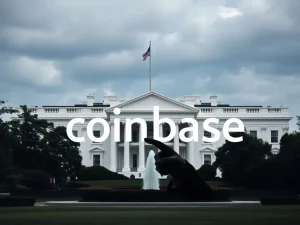Banks’ Fear of Stablecoins: Market Share Threat Triggers Legislative Battle

Are traditional banks feeling the heat from the crypto revolution? Absolutely. The latest buzz in the financial world is the escalating tension between banks and the burgeoning stablecoin market. It seems traditional financial institutions are deeply concerned about losing their grip as stablecoins gain traction. Let’s dive into why banks are pushing back against stablecoin legislation and what this means for the future of finance.
Why Banks Fear Stablecoin Legislation: Market Share Under Threat
The core of the issue? Market share. Banks are witnessing the rise of blockchain-based alternatives and are realizing their legacy systems are struggling to compete in terms of cost and efficiency. Stablecoins, with their promise of near-instant settlements and lower transaction fees, are perceived as a direct threat to the traditional banking model. Imagine a world where cross-border payments become seamless and peer-to-peer transactions bypass traditional banking infrastructure – this is the future stablecoins are hinting at, and banks are understandably worried.
The Guiding and Establishing National Innovation for US Stablecoins (GENIUS) Act is at the heart of this conflict. This bill, aimed at creating a regulatory framework for stablecoins, is facing significant resistance from banks and their allies in the US Senate. Here’s why:
- Disintermediation Fears: Banks fear that stablecoins will cut them out of the financial equation. If individuals and businesses can transact directly with stablecoins, the need for traditional banking services could diminish.
- Erosion of Revenue Streams: Transaction fees and other charges are vital revenue streams for banks. Stablecoins, offering significantly lower fees, pose a direct challenge to these income sources.
- Competition from Tech Firms: The prospect of tech giants issuing stablecoins, as highlighted by Senator Elizabeth Warren’s concerns, adds another layer of complexity and competition that banks are wary of.
The GENIUS Act: A Battlefield for Financial Supremacy?
The GENIUS Act is not just another piece of legislation; it’s a potential turning point in the financial landscape. Introduced by Senator Bill Hagerty, it aims to establish a comprehensive regulatory framework for dollar-pegged tokens. While some, like Federal Reserve Bank Governor Christopher Waller, see the potential benefits of stablecoins in expanding payment use cases and promoting efficiency, traditional banks are digging in their heels.
Senator Elizabeth Warren’s proposed amendment to the GENIUS Act, seeking to prohibit tech firms from issuing stablecoins, underscores the intensity of the debate. Warren argues for maintaining the status quo, where financial activities are conducted through regulated financial institutions. However, proponents of the GENIUS Act believe it’s crucial to adapt to the evolving digital landscape and harness the potential of stablecoins.
Stablecoins: A Pathway to USD Dominance or Banking Disruption?
The US government appears to be recognizing the strategic importance of stablecoins. Treasury Secretary Scott Bessent, during the first White House Crypto Summit, emphasized the role of stablecoins in extending US dollar dominance. This perspective aligns with the idea that embracing stablecoins could be a way for the US to maintain its financial leadership in the 21st century.
Consider these points about the potential of stablecoins:
- Global Reserve Currency Protection: Stablecoins can act as a mechanism to reinforce the dollar’s status as the global reserve currency by promoting its digital usage worldwide.
- Inflation Management: Overcollateralized stablecoin issuers are significant buyers of US government debt, potentially acting as a ‘sponge’ to absorb inflation.
- Modernizing Payments: Stablecoins offer a chance to modernize payment systems, particularly for cross-border transactions, making them faster and cheaper compared to legacy systems.
Bank of America CEO Brian Moynihan’s statement about potentially entering the stablecoin business suggests that even traditional banks are starting to acknowledge the inevitable shift. However, their pushback against the GENIUS Act indicates a desire to control the terms of this transition and protect their existing market share.
Navigating the Regulatory Maze: The Future of Stablecoin Legislation
The path forward for stablecoin legislation remains uncertain. The GENIUS Act requires significant bipartisan support to pass the Senate, and overcoming the resistance from banks and influential figures like Senator Warren will be a considerable challenge. The outcome of this legislative battle will have profound implications for the future of finance, shaping the role of stablecoins and the competitive landscape between traditional banks and the emerging digital asset ecosystem.
As the debate intensifies, it’s crucial to monitor the developments surrounding the GENIUS Act and the broader regulation of stablecoins. The decisions made in the coming months will determine whether the US embraces the innovative potential of stablecoins or attempts to maintain the traditional banking paradigm in the face of disruptive technological advancements.
Conclusion: A Financial Revolution or a Fight for Survival?
The clash over stablecoin legislation is more than just a political skirmish; it’s a reflection of a fundamental shift in the financial world. Banks are facing a stark choice: adapt to the changing landscape and integrate with the digital asset revolution, or fiercely defend their traditional market share and risk being left behind. The GENIUS Act and the ongoing debate surrounding it represent a critical juncture, one that will define the future of money and the balance of power in the global financial system. Keep a close watch – the stakes are incredibly high.








